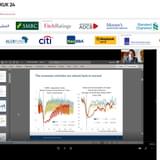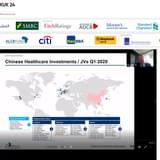Negative interest rates are now a common phenomenon across the world, and credit spreads are very tight. Many investors are asking where they can find income in the global fixed income market when positive yields seem elusive. Bloomberg World Sovereign Bond Indexes reflect that there are approximately US$9.9tn global bonds with negative yields. Japan leads the way in terms of total value of government bonds with yields below zero, and recently Germany became the first eurozone nation to sell a 10-year government bond at a negative yield. However, while times are tough for income investors, exposure to Chinese onshore bonds may add an important diversifying element and attractive potential yield opportunities to global bond portfolios.
Recently, the Bank for International Settlements (BIS) named China the world’s second largest economy and third largest bond market, yet noted that foreign investors currently account for only 2% of the onshore local currency bond market due to various structural restrictions that have limited foreign investment in China to date.
Recent steps by the People’s Bank of China (PBoC) appear likely to change that. These steps are part of a concerted effort by Chinese regulators and policymakers to open China’s capital accounts and encourage internationalization of China’s currency, the renminbi (RMB). Given the significance of events in China for the global economy, it is critical for asset managers, to understand and react to the changes underway with respect to China’s bond markets.
 One of the most significant changes has been China’s recent move to allow most types of institutional investors to invest in its onshore interbank bond market (CIBM). For most investors, this new avenue of investment provides an alternative to the previous exclusive methods of access through the qualified foreign institutional investor (QFII) and RMB qualified foreign institutional investor (RQFII) programs, which entail quotas and a more complex approval processes.
One of the most significant changes has been China’s recent move to allow most types of institutional investors to invest in its onshore interbank bond market (CIBM). For most investors, this new avenue of investment provides an alternative to the previous exclusive methods of access through the qualified foreign institutional investor (QFII) and RMB qualified foreign institutional investor (RQFII) programs, which entail quotas and a more complex approval processes.
Under the new rules, foreign commercial banks, insurance companies, securities companies, fund management companies, pension funds, charity funds, donation funds and other medium and long-term investors are now permitted to invest in the CIBM. Previously, foreign CIBM investment was restricted to foreign central banks, sovereign wealth funds, supranational organizations, RMB clearing banks, RMB settlement banks, select insurance companies and QFII/RQFII investors.
While observers had been anticipating an expansion of foreign investor access to Chinese markets for some time, the scope of the PBoC’s announcement took many by surprise. As more foreign investors are potentially attracted to the Chinese onshore RMB bond market, global capital flow dynamics are likely to change.
Although it is often considered an EM country, China has a relatively developed financial market. Because China’s onshore bond market has shown a low correlation to developed markets, it may be attractive for global investors. Chinese government bonds have also provided higher yields than the government bonds of the US, the UK, Germany, Japan, South Korea and Singapore for the same maturities, as of the end of March of this year. Although China’s onshore bond yields tightened by 60 to 80 basis points during 2015, as of the end of the first quarter of 2016, Chinese government bond yields still offered a 100 basis point spread over government bonds of several other Asian countries with significantly higher foreign exchange volatility, such as South Korea and Singapore. Onshore Chinese government bond yields traded 100 to 200 basis points over US and UK government bonds and around 300 basis points over Japan and Germany’s, which have been trending deeper into negative territory. Chinese onshore government bonds were also less volatile than the major global bond markets in the last five years and trading volumes and turnover ratios have been strong in the last year.
In addition to currently offering attractive yields, lower volatility and ample liquidity, there are some interesting relative value opportunities among China’s three major bond markets - the onshore RMB market, the offshore renmimbi (RMB) market and the RMB-hedged US dollar bond market. As these markets become more open, foreign investors can take advantage of potential arbitrage opportunities, potentially causing yields in the three markets to converge.
China’s bond market has yet to be included in major local currency bond indices, partly due to the lengthy approval process, quota and repatriation constraints previously applicable to foreign investors. Further details and final confirmation regarding the “lock-up” period and repatriation are still under consideration, and the PBoC’s recent announcement has brought China’s onshore bond market closer to being considered for inclusion in major global bond indices. While the certainty, extent and timing of any such move remains unclear, if major bond indices do incorporate China’s bond market, investment portfolios tracking the relevant indices would likely need to increase their purchases of onshore Chinese bonds accordingly. Related inflows could ultimately reach $200bn to $400bn from fund managers alone, based on the potential weight of Chinese onshore bonds in the indices and the estimated size of assets tracking these indices.
While investing in China’s onshore bond market presents attractive opportunities compared to global peers, some areas still require additional clarification from the PBoC, such as tax treatment and registration. Key risks revolve around China’s macro environment and policy direction, corporate credit risk and the need for greater objectivity in local credit ratings. The onshore credit rating system is different from the international system and tends to be more lenient. Corporate default rates in the onshore RMB market may rise as the Chinese economy slows and government policy focuses on curbing leverage in the system. In addition, operational risks exist due to regulatory complexity and the different market dealing and settlement practices in the Chinese onshore bond market.
As China continues to liberalize its capital accounts and financial markets, the offshore RMB bond market is likely to evolve into the RMB’s version of the Eurodollar market and the onshore Chinese bond market may develop further into a major investment platform, given its large size and liquidity advantages. The compelling arbitrage opportunities offered by the three markets may not last indefinitely as RMB internationalization progresses. Chinese onshore bonds currently offer the potential to achieve relatively attractive yields, diversification, volatility and liquidity benefits. And while uncertainties and risks certainly remain, the importance of the Chinese fixed income market - the third largest in the world - makes it crucial for global investors to understand and evaluate fully their options for gaining exposure to it.





